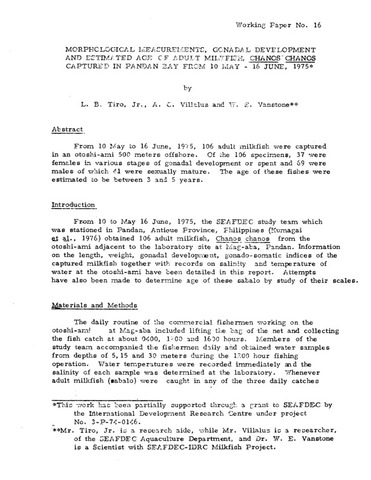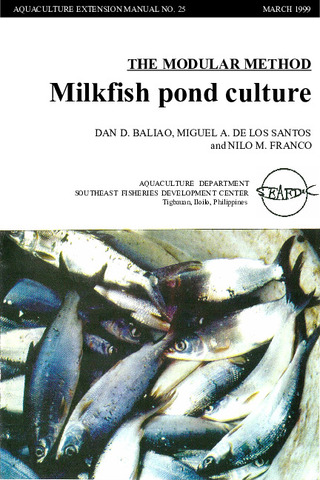Morphological measurements, gonadal development and estimated age of adult milkfish, Chanos chanos captured in Pandan Bay from 10 May - 16 June, 1975
- Global styles
- MLA
- Vancouver
- Elsevier - Harvard
- APA
- Help

Date
1976Page views
5,407ASFA keyword
AGROVOC keyword
Taxonomic term
Geographic names
Metadata
Show full item record
Share
Abstract
From 10 May to 16 June, 1975, 106 adult milkfish were captured in an otoshi-ami 500 meters offshore. Of the 106 specimens, 37 were females in various stages of gonadal development or spent and 69 were males of which 41 were sexually mature. The age of these fishes were estimated to be between 3 and 5 years.
Suggested Citation
Tiro Jr., L. B., Villaluz, A. C., & Vanstone, W. E. (1976). Morphological measurements, gonadal development and estimated age of adult milkfish, Chanos chanos captured in Pandan Bay from 10 May - 16 June, 1975. In Proceedings of the International Milkfish Workshop Conference, May 19-22, 1976, Tigbauan, Iloilo, Philippines (pp. 193-203). Tigbauan, Iloilo, Philippines: Aquaculture Department, Southeast Asian Fisheries Development Center.
Type
Conference paperCollections
Related items
Showing items related by title, author, creator and subject.
-
Series: Aquaculture extension manual; No. 25
The modular method: Milkfish pond culture
Baliao, Dan D.; de los Santos, Miguel A.; Franco, Nilo M. (Aquaculture Department, Southeast Asian Fisheries Development Center, 1999)The modular method of milkfish culture (Chanos chanos) described in the manual is an improvement over the traditional extensive method. The manual is intended for the use of fish farmers and aquaculturists, extensionists, ... -
Evaluation of organic and inorganic fertilizers in brackishwater milkfish ponds
Bombeo-Tuburan, Isidra; Agbayani, Renato F.; Subosa, Precilla F. (Elsevier, 1989)The study was conducted in twelve 144-m2 ponds to evaluate the effect of different organic and inorganic fertilizers on the growth, survival, gross production, and profitability of marketable milkfish. The ... -
Milkfish breeding and hatchery technology at SEAFDEC/AQD
Unknown author (Aquaculture Department, Southeast Asian Fisheries Development Center, 1999)Describes the techniques already adopted by the private sector: broodstock management, broodstock diet, commercial fry production, live transport, and larval diet. A list of AQD research publications on milkfish is included.







